|
Santiago de Chile
By Bus to Santiago
I arrived at the 5-km distant terminal of the TUR BUS company in Antofagasta. I was there almost an hour before the time of the bus departure, having allowed for emergencies along the way. I greatly enjoyed cycling with two front bags and basked in the feeling that everything was as it should be (which usually does not last long). I prepared my equipment for transport – I unscrewed the pedals and turned the handlebars around. I tied the bags together in pairs with straps, left the tent and sleeping bag in the bag and added all the electronic gadgets – chargers, cables, etc. This bundle, with my backpack containing the computer, camera, Kindle and GPS, went on to the bus with me. A loss of a bag from the luggage compartment would be unpleasant, but replaceable.
The trip was extremely boring. We left at 12.35 p.m., the first stop was at 9 p.m. In the meantime, there was just desert, desert, desert, desert, desert, and again, all the time, the same desert. It was a good thing I had not cycled that distance, as I would have yawned myself to death. At the first stop, we were expelled from the bus due to engine failure and we had to get on another bus. Although both the driver and steward knew I had a bike, they happily filled up the luggage compartment and then wondered where they were going to put my bike. Eventually they put it into the space above the spare tire, but they put it there with the derailleur gear facing downwards. I could imagine the wheel jumping up on a bump and bending the gear base and then I would have to solve the problem of changing gears. So I forced them to take the bike out and turn it over, with the derailleur on top. It was a battle, but I won. And it was also good that I had removed the pedals and turned the handlebars around, otherwise we could not have stuffed the bike into the space.
We arrived at Santiago two hours late, at 8 a.m. That was fine with me because of accommodation, mostly there are no rooms available early in the morning. I had thought of staying in the district of Paris-Londres, which is actually only three English-style paved streets about a ten-minute walk from Plaza de Armas. So I entered it into the GPS, and came up with nothing. The map of Chile, which I had bought for the GPS in Bolivia, had a number of uncovered places in the capital, and this was one of them. But I managed to solve the problem. I found the surrounding streets in the guidebook on the Kindle, and the GPS located San Diego Street. I cycled the main artery, Avenue Liberator O'Higgins (commonly called Alameda), which has separate lanes and a park in the middle with a cycle track. The cycle track was added later, so it crosses the steps by means of steep ramps that are already almost falling apart. However, I was separated from the heavy Monday traffic and this was important. There were no street name signs. According to the mileage, I figured I had to be close. Yes, I hit it precisely and entered Londres Street. They only had accommodation for one night in the first hostel, but a guy grabbed me there, saying he knew a super hostel about 200 meters away, so I let him take me there. And indeed, it was an affordable price at 8,000 Pesos (about 15 USD per night) with breakfast, WiFi in several places, a window in the room and towels. It was clean—and they spoke English at the reception desk.
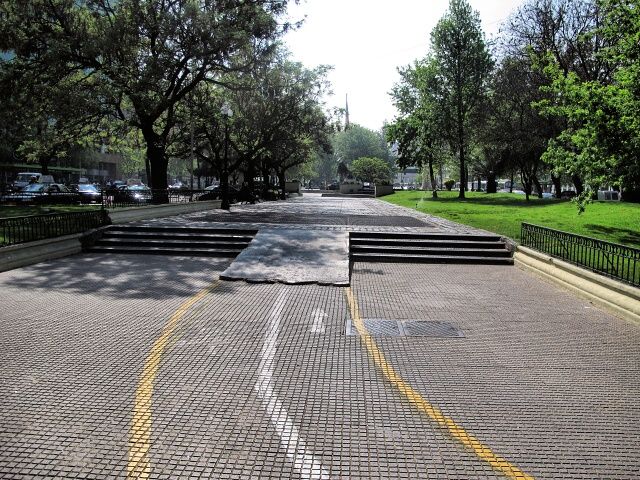
[Santiago de Chile] Avenue Liberator O'Higgins (Alameda)—the main arterial road with a park in the center and a cycle path through it
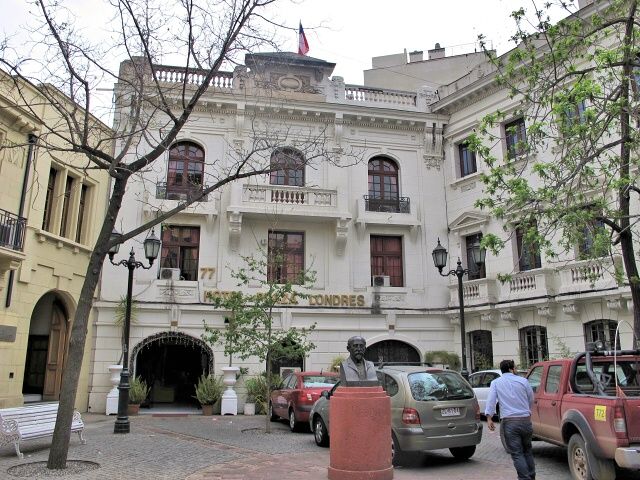
[Santiago de Chile] A very cozy hostel, cheap and close to the city center
I Restock the Equipment
I needed new shorts, a right side mirror, a spare magnet for the cyclocomputer and a bottle holder. There are about 30 bike stores in San Diego Street, but I was not successful in my shopping, except for the magnet. Even that I only found in about the 25th store. Cycling shorts were sold in only one store, quite good quality for about 80 USD. However, my wallet with identification papers did not fit into the pockets, so they were not suitable. Out of curiosity, I also asked about a front pannier rack and nobody had any. Then I recalled that, on the receipt from the bike store where I had bought the carrier, there were the addresses of stores in other cities. I took a subway to Providence and there in a store with Oxford bikes, I bought a good right side mirror by Zefal (relabeled as an Oxford brand!) for 8 USD. They also had the same front pannier rack as I had purchased in Antofagasta and also another pretty good one by Zefal. They also had shorts, but they did not fit me. Eventually I bought plain shorts in a stronger fabric on a sale for about 25 USD. They seemed good, were not too tight-fitting and the pockets held everything I needed. I was a little worried about the recurring problem with my Visa card, as I had been unable to pay with it at the retailers. This could have caused a problem, so I tried an ATM and there the goose laid the golden eggs, with quite a few banknotes popping out. So everything was all right.
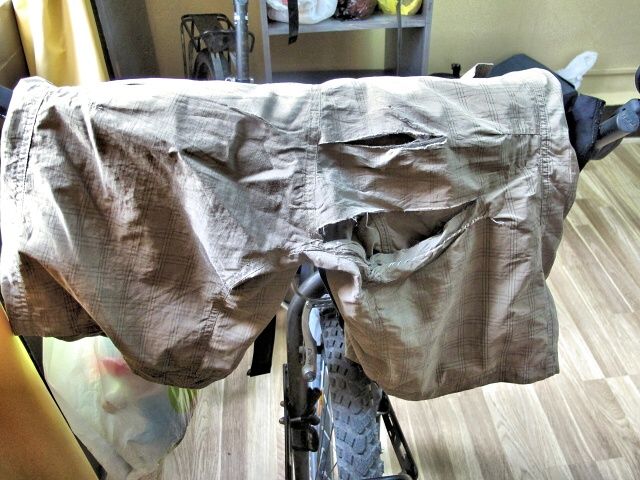
[Santiago de Chile] My shorts after approx. 2000 km ended up in the garbage without me shedding a single tear
The next task was to buy a ticket to Easter Island. It was only a five-hour flight, I would never be any closer to it in my lifetime. There was only one company, LAN, operating flights to this island. The catalogue offered attractive packages with accommodation and meals at very reasonable prices, but the reality was different. A return ticket for about 850 USD. They did not sell bicycle crates at the airport, so I solved the problem by shrink-wrapping it. I got a big roll for around 5 USD at the first hardware store. I would cycle to the Santiago Airport (about 16 km according to the GPS), reach the island at 8.30 p.m. and would bivouac the first night somewhere near the Airport.

[Santiago de Chile] Presidential palace

[Santiago de Chile] The Cathedral on Plaza de Armas: Virgen del Carmen – Queen and Mother of Chile (according to Catholics)
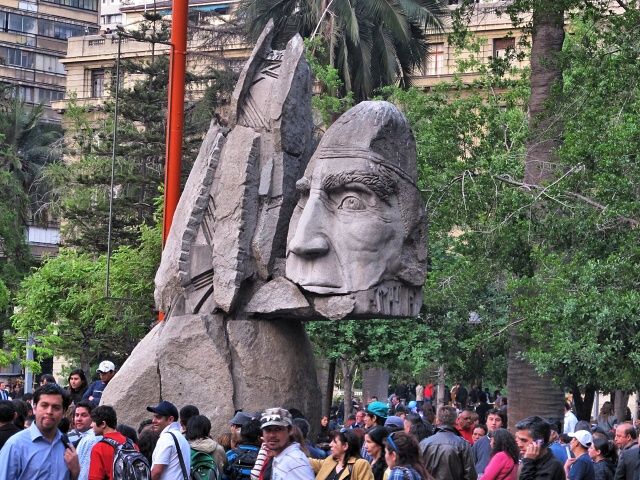
[Santiago de Chile] Plaza de Armas – a very strange and perturbing statue
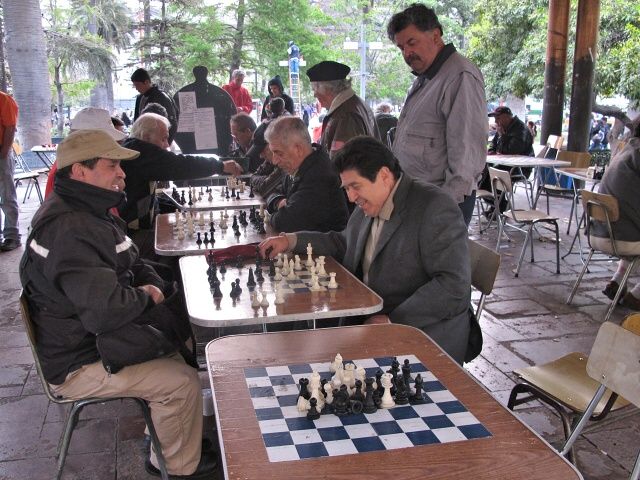
[Santiago de Chile] Chess players meet on Plaza de Armas
Ministry of Public Works
I visited this office the next morning. Not because I would perhaps have liked to roll up my sleeves and start building Chile, I would leave that to the younger enthusiasts, but because I needed a map. There were terrible creations in the stores, but some of the best maps were simply available at the Ministry. For about 15 USD, I got quality maps of the whole of Chile in four separate files. Only a better overview of the topography (altitudes and terrain undulation) was missing. The disadvantage of these maps was that they were strictly limited to Chile and, beyond the borders, they were white or beige, with no trace of subsequent routes. This matters in the southern regions, where it is necessary to repeatedly pass between Chile and Argentina. So I also visited the Military Cartographic Institute where, among other things, it was possible to buy about 500 separate cadastral maps with detailed topography covering the entire territory (but I would probably have required an accompanying vehicle to carry all of those). However, they also had a road map with connections to the Argentinian routes in the critical areas, so I bought one for 5 USD. In combination with the GPS, this should have proved adequate. But I made the mistake of not also buying a GPS map of Argentina. After returning from Easter Island, I would try to get one.

[Santiago de Chile] A street comic
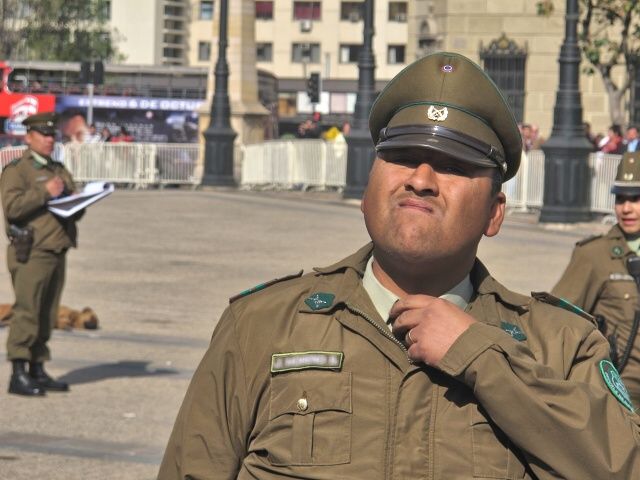
[Santiago de Chile] To get a job in the Chilean Police isn't easy, the aspirant must look bright even from a distance
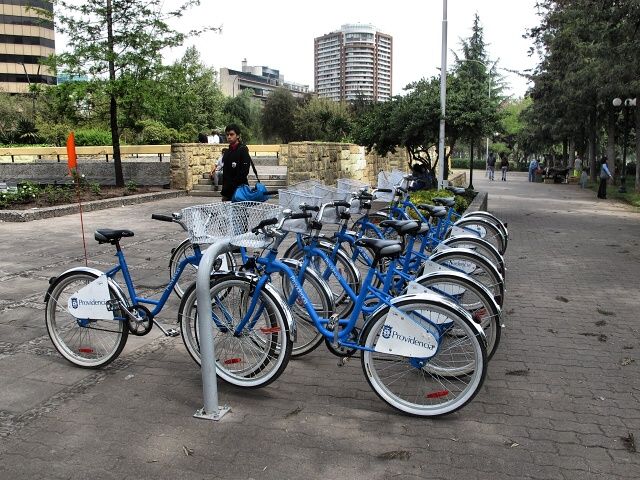
[Santiago de Chile] The city bikes for hire in Providence appeared to be free

[Santiago de Chile] Extremely filthy and stinky Rio Mapocho
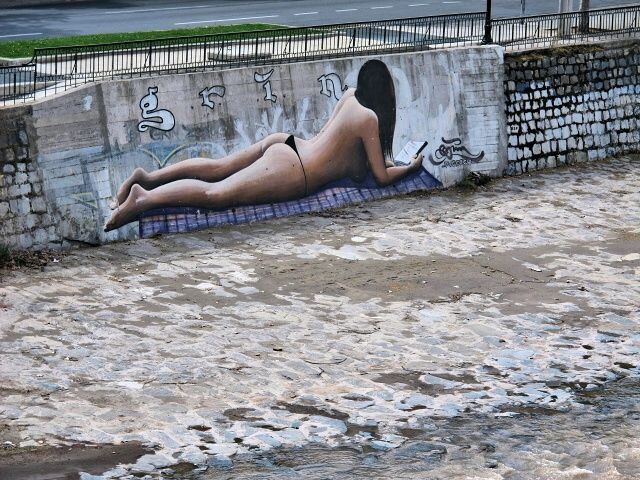
[Santiago de Chile] On the riverbank of stinky Rio Mapocho a joker drew a sunbathing girl
The Subway
It is distinctive here in that it has two different fares, depending on whether you are traveling during peak hours or in off-peak periods. These time periods are fixed. The ticket to travel in off-peak periods costs about 1 USD and you can change trains an unlimited number of times before your destination. There are also special rates for Seniors. This fare is 180 Pesos (about 0.3 USD) and it can be used only during off-peak hours (which is almost the whole day from 9 a.m., with the exception of the two-hour evening rush hour). So I was interested in this special fare. Firstly, one has to be issued with an identity card proving that one is old enough to be entitled to the cheap tickets. That was not a problem, it was issued in several places and foreigners were not discriminated against. However, it was not worth it for my two journeys, so I paid the full fare as a young, capable lad.
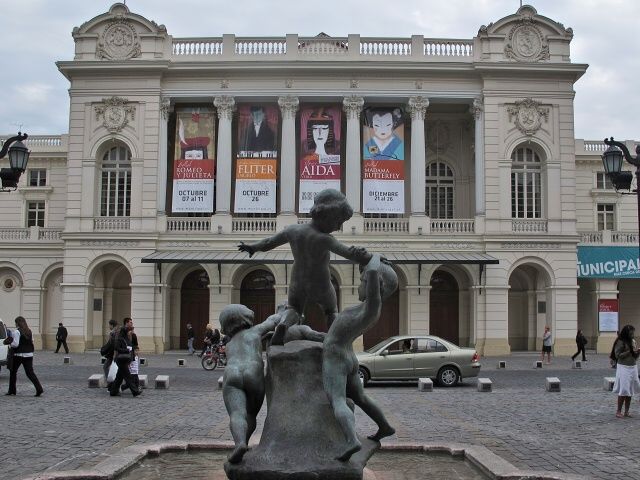
[Santiago de Chile] The City Theater
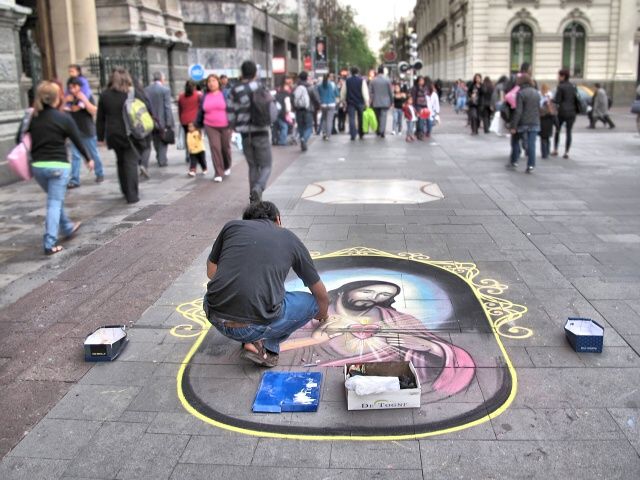
[Santiago de Chile] A pavement artist in front of the Cathedral; he kept drawing the picture every day – to be washed away during the night
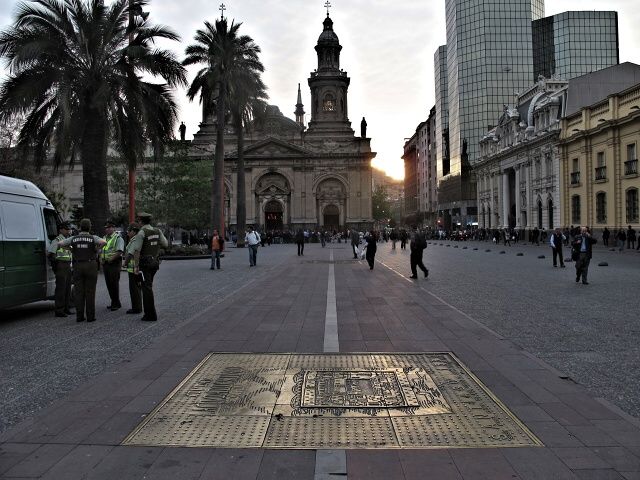
[Santiago de Chile] City plans from various epochs, cast in brass on Plaza de Armas
Fellow Countrymen from Krčeň
In the morning, I was quietly eating my hostel breakfast, when a portly gentleman of about my age marched in, followed by four young women. Their chatter in Czech could not be ignored, so I started to speak to them. The bunch was from Brno University, having attended a conference on fish parasites and now they wanted to travel a little. They intended to rent a car and drive to San Pedro de Atacama and back to Santiago, before flying home. A pleasant encounter, except that at noon I began to feel an itch under my right arm, could it have been some kind of fish parasite?
To Easter Island
In the morning, I walked around the neighborhood to find a box and some cardboard for wrapping the sensitive areas of my bicycle that evening. However, after returning from a research tour of the Santiago pubs (of which there were many in the street) and a few beers as a true caballero, I felt too uplifted for such a menial task. In the morning, all my cardboard was gone. The garbage collectors had done their job well. But in the end, I managed to solve the problem. As usual, weight was a problem. The lady selling tickets had informed me that the limit was 46 kg. No problem, I thought, I’d be within the limits, even with a wrapped iron girder. However, when studying the ticket later, I discovered with astonishment that it was “ida y vuelta”, meaning that the limit applied for the return flight, so it was actually 23 kg. one-way. That was not achievable, even with the use of all my tricks at losing weight. As a last resort, I would have to resort to refined psychology, informing them that I weighed 63 kg and then point at some obese passenger, asking if that was indeed fair, verdad? Anyway, I did my best, leaving a box of things at the hostel that probably would not be needed or that could not be taken on the plane (gas cylinder, lighters, warm clothing, emergency supply of canned food, etc.).
The ride to the Airport was easy. First, I struggled through the jam-packed city traffic down to the river, where I turned left and cycled in the park along the river. The highway to the Airport was on the other side of the river, but that did not interest me. The park turned into a garbage-covered periphery, the road deteriorated, there were slums all around, but no problem. Suddenly a brand new road appeared, which in its 3-km length led from nowhere to nowhere, because the entrance was obstructed by concrete blocks on to which the innovative local residents had piled a two-meter layer of garbage. Of course I did not stop, but enjoyed the route without any cars. The new road turned into a local road which, about 2 km further on, led on to the Airport highway, but I had to enter it from the opposite direction. Cyclists are forbidden on the highway, but the passing carabineros left me alone. Long-distance cyclists surely are entitled to a little indulgence.
The foil-wrapping proceeded quickly. I even found a volunteer who came and held the bike, so that I could foil-wrap it. Unfortunately, his ordered taxi arrived 10 minutes later, but he had helped me a great deal in the initial stages of the wrapping, when there were still many loose ends and the bike did not keep its shape. The work was flowing so well that I recalled a favorite book by Pirsig, “Zen and the Art of Motorcycle Maintenance” and thought I would write my own fresh piece, “Thirst and the Art of Bicycle Packing”. I just had my doubts whether anyone would read it. Yeah, Pirsig is known at least to the experts, I envy him and take my hat off to him.
Reality Check at the Check-in
When everything was ready, I moved to the LAN company check-in counter. I left my bike on the cart to one side, it was unnecessary to struggle with it through the labyrinth of stretched ropes dimensioned for hundreds of passengers. Everything was fine, until I mentioned the bike and pointed at the cart. "No way!" said the lady clerk at the counter uncompromisingly. "A bike wrapped like that, nope!" But she sent my remaining bags off on the belt. I let them enter the tunnel beyond her reach, and then resolutely said that, without the bike I was not flying anywhere, and that I wanted my luggage returned. But the bags had already disappeared into the tunnel and were out of reach. The Senora faltered. We were in the middle of the check-in procedure, neither of us willing to compromise. She closed her desk and called her superiors. The Manager arrived. I told him that I also pack my bike like this for trans-oceanic flights and that it was done at my own risk. He consulted the Manual. Finally he concluded that if no panels were sticking out of it, they did not mind, but I would have to sign the “own risk” declaration. No problema. Then we weighed the bike, I lifted the bike up slightly in the tense atmosphere and it was a total special weight of 9.15 kg. Lance Armstrong would not be ashamed to race the Tour de France on it (the actual weight with the carriers is about 16 kg! My other luggage weighed 13 kg, so that is how I complied with the weight limit.
The security clearance was good-humored. There was a really pretty chick at the scanner. She saw the SPD pedals and spanner in the bag and did not know what to do with them. She called a colleague who addressed her as “corazón” (darling), which really suited her. I said in Spanish, that these were my bicycle pedals and spanner (“llava”). And she told me, "Yeah, llave, comprendo”. Well I did not get the last letter in the word right, so I ran around the scanner, shook her hand and thanked her for the Spanish lesson. A pleasant moment, we all laughed. In Europe they might have put me in jail for that.

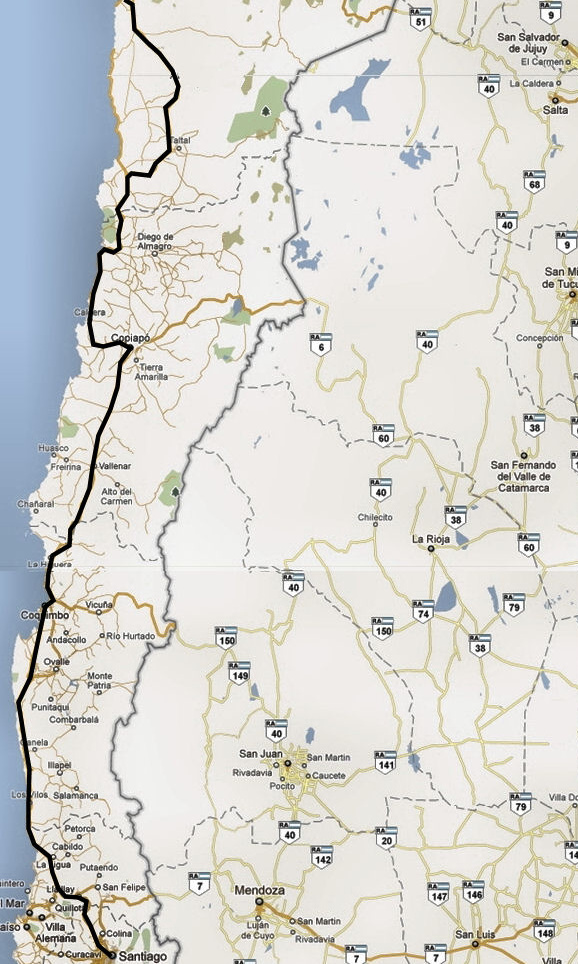
|
























